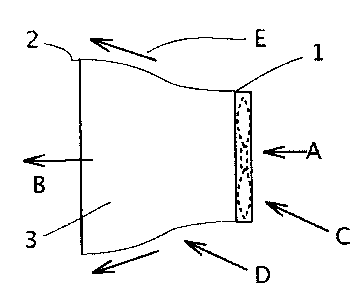Une partie des informations de ce site Web a été fournie par des sources externes. Le gouvernement du Canada n'assume aucune responsabilité concernant la précision, l'actualité ou la fiabilité des informations fournies par les sources externes. Les utilisateurs qui désirent employer cette information devraient consulter directement la source des informations. Le contenu fourni par les sources externes n'est pas assujetti aux exigences sur les langues officielles, la protection des renseignements personnels et l'accessibilité.
L'apparition de différences dans le texte et l'image des Revendications et de l'Abrégé dépend du moment auquel le document est publié. Les textes des Revendications et de l'Abrégé sont affichés :
| (12) Demande de brevet: | (11) CA 2605835 |
|---|---|
| (54) Titre français: | SURPRESSEUR EOLIEN |
| (54) Titre anglais: | WIND BOOSTER |
| Statut: | Réputée abandonnée et au-delà du délai pour le rétablissement - en attente de la réponse à l’avis de communication rejetée |
| (51) Classification internationale des brevets (CIB): |
|
|---|---|
| (72) Inventeurs : |
|
| (73) Titulaires : |
|
| (71) Demandeurs : |
|
| (74) Agent: | |
| (74) Co-agent: | |
| (45) Délivré: | |
| (22) Date de dépôt: | 2007-10-03 |
| (41) Mise à la disponibilité du public: | 2009-04-03 |
| Licence disponible: | S.O. |
| Cédé au domaine public: | S.O. |
| (25) Langue des documents déposés: | Anglais |
| Traité de coopération en matière de brevets (PCT): | Non |
|---|
| (30) Données de priorité de la demande: | S.O. |
|---|
The present invention is a method and apparatus to increase air speed through
a turbine
such as in a wind power generator. The method comprises creating a low
pressure area behind
(or, downstream) of the turbine so as to cause the wind entering the turbine
to be accelerated
thereby adding torque for the turbine to turn the generator. The apparatus
comprises a
generally conic shaped, open-ended hood that extends behind the turbine to act
as an airfoil
and so cause an increase in air speed along its lengthening outer surface,
which, in turn,
lowers the pressure in the interior of the hood. Wind will thus be 'drawn'
into the resulting
partial vacuum thereby raising wind speed. Also disclosed is a mobile use
where a turbine
generator is shrouded to the the rear of a vehicle with an opening to enable
fir flow to enter
the shroud and drive the turbine as the air seeks the naturally-occurring low
pressure area to
the rear of the vehicle and shrouded turbine.
Note : Les revendications sont présentées dans la langue officielle dans laquelle elles ont été soumises.
Note : Les descriptions sont présentées dans la langue officielle dans laquelle elles ont été soumises.

2024-08-01 : Dans le cadre de la transition vers les Brevets de nouvelle génération (BNG), la base de données sur les brevets canadiens (BDBC) contient désormais un Historique d'événement plus détaillé, qui reproduit le Journal des événements de notre nouvelle solution interne.
Veuillez noter que les événements débutant par « Inactive : » se réfèrent à des événements qui ne sont plus utilisés dans notre nouvelle solution interne.
Pour une meilleure compréhension de l'état de la demande ou brevet qui figure sur cette page, la rubrique Mise en garde , et les descriptions de Brevet , Historique d'événement , Taxes périodiques et Historique des paiements devraient être consultées.
| Description | Date |
|---|---|
| Demande non rétablie avant l'échéance | 2012-10-03 |
| Le délai pour l'annulation est expiré | 2012-10-03 |
| Inactive : Demande ad hoc documentée | 2012-07-05 |
| Réputée abandonnée - omission de répondre à un avis sur les taxes pour le maintien en état | 2011-10-03 |
| Demande publiée (accessible au public) | 2009-04-03 |
| Inactive : Page couverture publiée | 2009-04-02 |
| Inactive : Correspondance - Formalités | 2008-12-29 |
| Inactive : CIB attribuée | 2007-12-10 |
| Inactive : CIB en 1re position | 2007-12-10 |
| Inactive : CIB attribuée | 2007-12-10 |
| Inactive : Certificat de dépôt - Sans RE (Anglais) | 2007-11-16 |
| Demande reçue - nationale ordinaire | 2007-11-16 |
| Modification reçue - modification volontaire | 2007-10-22 |
| Déclaration du statut de petite entité jugée conforme | 2007-10-03 |
| Date d'abandonnement | Raison | Date de rétablissement |
|---|---|---|
| 2011-10-03 |
Le dernier paiement a été reçu le 2010-07-28
Avis : Si le paiement en totalité n'a pas été reçu au plus tard à la date indiquée, une taxe supplémentaire peut être imposée, soit une des taxes suivantes :
Les taxes sur les brevets sont ajustées au 1er janvier de chaque année. Les montants ci-dessus sont les montants actuels s'ils sont reçus au plus tard le 31 décembre de l'année en cours.
Veuillez vous référer à la page web des
taxes sur les brevets
de l'OPIC pour voir tous les montants actuels des taxes.
| Type de taxes | Anniversaire | Échéance | Date payée |
|---|---|---|---|
| Taxe pour le dépôt - petite | 2007-10-03 | ||
| TM (demande, 2e anniv.) - petite | 02 | 2009-10-05 | 2009-08-10 |
| TM (demande, 3e anniv.) - petite | 03 | 2010-10-04 | 2010-07-28 |
Les titulaires actuels et antérieures au dossier sont affichés en ordre alphabétique.
| Titulaires actuels au dossier |
|---|
| WINSTON MACKELVIE |
| Titulaires antérieures au dossier |
|---|
| S.O. |